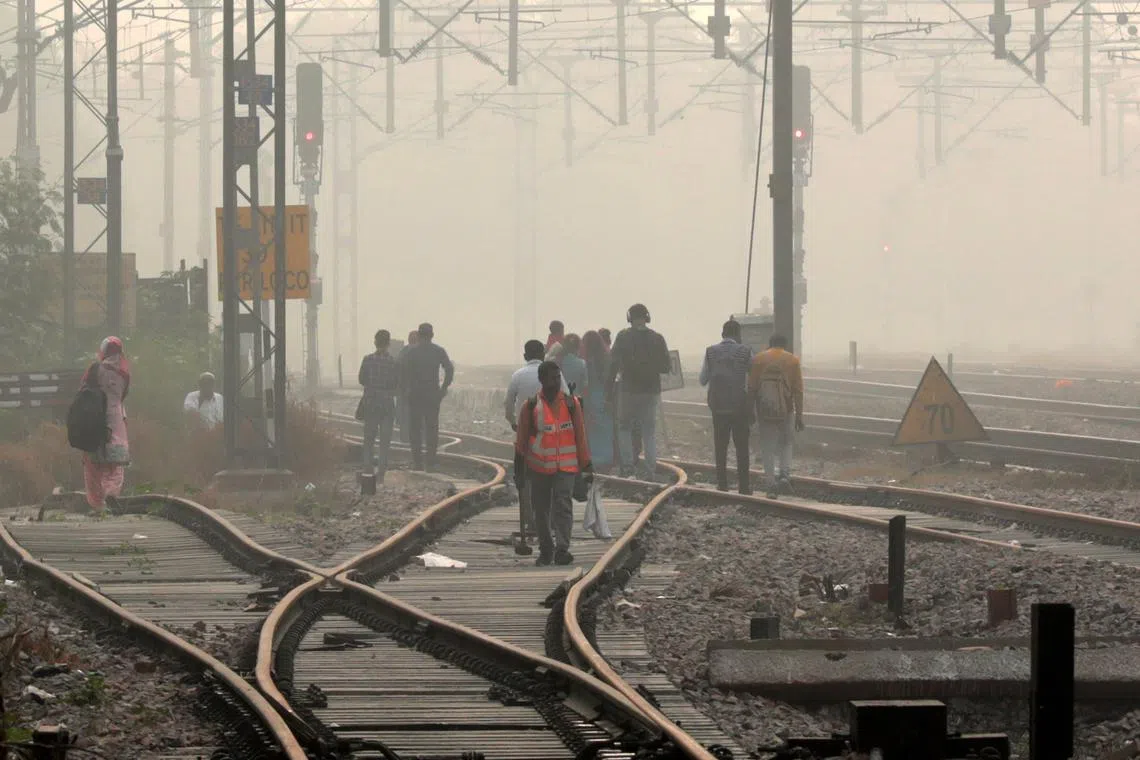As the rich resort to air purifiers, India’s poor struggle amid Delhi’s pollution
Sign up now: Get ST's newsletters delivered to your inbox

Commuters walking on a railway track as a thick layer of smog engulfs the city in New Delhi on Nov 5, 2022.
PHOTO: EPA-EFE
Follow topic:
NEW DELHI - Mr Prahlad Chaudhary, a daily wage worker at a construction site near Delhi, has been out of work since Oct 29. That was the day when construction activity was banned across the National Capital Region, given deteriorating pollution levels.
There was little respite for the 30-year-old and his family on Saturday morning, when the air quality index (AQI) in Delhi, the world’s most polluted capital, and its adjacent areas remained in the “severe” category for a third consecutive day.
The losses have been piling up for Mr Chaudhary and his wife, who also works with him at the construction site in Noida, a Delhi suburb. The couple earn about 450 rupees (S$8) for each day’s work. The pollution-induced ban has already set them back by more than 7,000 rupees, a significant loss for these two poor migrants from Panna district in Madhya Pradesh, a central Indian state.
Worries about any potential impact from pollution on their health pale in comparison to the existential crisis they find themselves in today because of unemployment. “If this continues for another day, I will have to go back home,” Mr Chaudhary said.
Their eight-month-old grubby daughter, Sahara, played with a paper cup on the dusty road, sniffling from a persistent cold.
Concerns about the impact of the ongoing bout of severe pollution on Delhi’s children forced the city to shut its primary schools
Newspapers in the city in recent days have been dotted not just with reports of alarming pollution levels, but also advertisements for immunity boosters, including one with unproven claims to fight pollution-related impacts on the lung.
Air purifier companies have also turned on their marketing campaigns amid a surge in their sales. Some of Delhi’s desperate residents have even turned to social media for a dose of dark humour to help them cope with the crisis. “Smoking in Delhi is healthier than doing yoga in Delhi,” said a tweet on Nov 4 from @sagarcasm.
Hospitals in Delhi and neighbouring regions have, meanwhile, already reported a rise in cases of respiratory illnesses, a phenomenon observed every winter. Dr Naresh Kumar, head of the department of pulmonary medicine at Maulana Azad Medical College in Delhi, said there has been a rise of about 10 - 15 per cent in the number of patients admitted to the college’s affiliated hospital with respiratory problems since the onset of the pollution crisis post-Diwali.
He added that interim measures such as banning diesel vehicles and shutting down schools will do little to contain the recurring problem. “You need serious long-term awareness with a public campaign at least three months before winter to see how emissions can be reduced,” he said.
The focus on pollution-related discussions in Delhi has been on farm fires from Punjab and other neighbouring states in recent days, which contributed around 34 per cent of PM2.5 particles on Nov 3, a day when the AQI was “severe”. Last year, the share of farm fires in Delhi’s PM2.5 load had peaked at 48 per cent on Nov 7.
Much of the pollution in Delhi, however, comes from sources such as vehicles, industries and power generation units that contribute around 65 per cent of PM2.5 particles in Delhi on average.
Mr Sunil Dahiya, an analyst at the Centre for Research on Energy and Clean Air, said the larger narrative around pollution sources has “put people at the centre”, shielding “big polluters” such as coal power plants from the debate. “The big polluters have been hiding behind people,” he said.
In September, India extended a deadline for coal-fired power plants across the country to install equipment to reduce sulphur emissions by two years to the end of 2027, the third such relaxation for the industry.
According to a study published last year, 11 coal-fired power plants in the National Capital Region contributed 7 per cent to Delhi’s PM2.5 pollution on average between October 2020 and January 2021, while vehicles contributed 14 per cent.
“Emissions from a single stack are equivalent to those from hundreds of thousands of cars, and strong regulation of industries such as coal-fired plants and petrochemicals can lead to significant impacts,” Mr Dahiya added.


